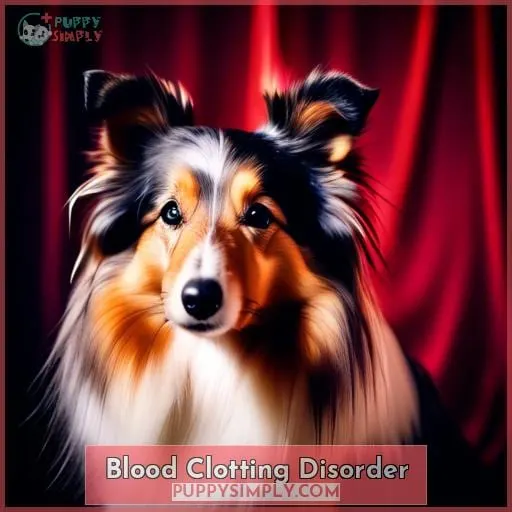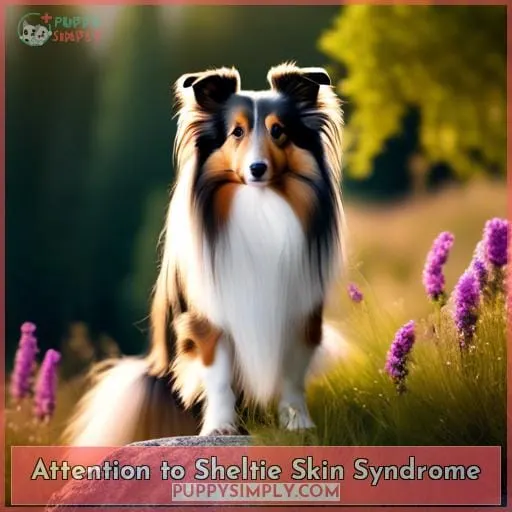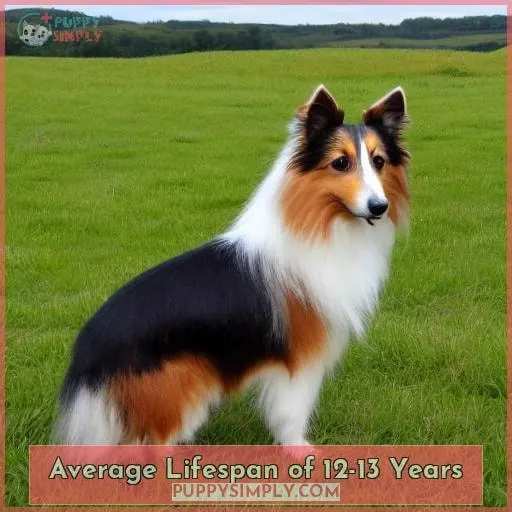This site is supported by our readers. We may earn a commission, at no cost to you, if you purchase through links.
 Discover the enchanting world of Shetland Sheepdogs, where intelligence, loyalty, and grace intertwine.
Discover the enchanting world of Shetland Sheepdogs, where intelligence, loyalty, and grace intertwine.
Embark on a journey to understand the unique characteristics of these captivating creatures, from their diminutive size to their remarkable abilities.
Delve into the depths of their temperament, uncovering the secrets of their affectionate nature and unwavering devotion.
Explore the intricacies of their care, ensuring you provide the optimal environment for your beloved Sheltie to thrive.
Table Of Contents
- Key Takeaways
- Origin: Shetland Islands, Scotland
- Height: 13-16 Inches
- Weight: 15-25 Pounds
- Lifespan: 12-14 Years
- Coat: Double-coated, Requires Regular Grooming
- Intelligence: Ranked 6th Overall
- Temperament: Affectionate, Loyal, Sensitive, Vocal
- Size: Small to Medium
- Coat Type: Double Coat, Heavy Shedding
- Grooming Needs: High
- Genetic Condition Affecting the Hip Joint
- Inherited Eye Condition
- Dermatomyositis, Affecting Skin and Muscles
- Common Endocrine Issue
- Blood Clotting Disorder
- Diet: High-quality Dog Food
- Feeding Frequency: Adults Twice Daily, Puppies 3-4 Times
- Supplements: Glucosamine, Chondroitin, Omega-3s
- Intelligent, Eager to Please, Good With Children
- Highly Trainable, Excel in Agility and Obedience
- Natural Alarm Dogs, Prone to Barking
- Frequent Brushing to Prevent Matting
- Attention to Sheltie Skin Syndrome
- Regular Cleaning Recommended
- Daily Physical and Mental Stimulation Needed
- Early Socialization Important
- Adaptable to Various Living Situations With Proper Exercise
- Not Miniature Collies, Distinct Breed
- Require More Than Just Physical Exercise, Mental Stimulation is Crucial
- Average Lifespan of 12-13 Years
- Health Considerations for Aging Shelties
- Frequently Asked Questions (FAQs)
- How often should I bathe my Sheltie?
- What kind of grooming tools should I use to care for my Sheltie’s coat?
- Are Shelties prone to specific health issues, and how can I prevent them?
- How much exercise does a Sheltie typically need each day?
- What kind of mental stimulation activities are suitable for a Sheltie?
- Conclusion
Key Takeaways
- Shetland Sheepdogs (Shelties) typically measure between 13 and 16 inches in height and weigh between 15 and 25 pounds.
- They are compact and agile companions, making them well-suited for apartment living despite their remarkable strength and agility.
- Shetland Sheepdogs are intelligent and eager to please, making them highly trainable and excellent in agility and obedience competitions.
- Early socialization is crucial for Shetland Sheepdogs to prevent separation anxiety, destructive behavior, leash reactivity, and excessive barking.
Origin: Shetland Islands, Scotland
Let’s explore the origins of the Shetland Sheepdog, tracing their roots back to the rugged landscapes of the Shetland Islands in Scotland.
These islands, battered by the North Atlantic winds, are known for their dramatic coastline, rich history, and unique culture.
The Shetland Sheepdog, like the Shetland pony and the Shetland dialect, is a product of this harsh yet beautiful environment.
The Shetland Islands, located northeast of mainland Scotland, have a long and fascinating history.
Inhabited since Neolithic times, the islands have been influenced by various cultures, including the Vikings, the Norse, and the Scots.
This rich heritage is reflected in the islands’ traditions, language, and music, which attract tourists worldwide.
Height: 13-16 Inches
Standing between 13 and 16 inches tall, Shelties are compact and agile companions.
Their small size makes them well-suited for apartment living and easy to handle for owners of all ages.
Despite their diminutive stature, Shelties possess remarkable strength and agility, enabling them to excel in various canine sports such as agility and obedience.
While their size may vary slightly depending on factors like gender and genetics, reputable breeders strive to adhere to breed standards, ensuring the preservation of the Shetland Sheepdog’s distinctive characteristics.
Understanding the breed’s size and growth patterns is crucial for providing appropriate care and ensuring the well-being of your Sheltie throughout its life.
Weight: 15-25 Pounds
Adult Shelties typically weigh between 15 and 25 pounds, making them a small to medium-sized breed.
This weight range is set by breeding standards to ensure Shelties retain their agility and herding instincts.
Their compact size makes them adaptable to various living situations, from apartments to houses with yards.
Shelties come in a variety of coat colors, including sable, tri-color, and blue merle.
Their thick double coat requires regular grooming to prevent matting and shedding.
Despite their small size, Shelties have a strong herding instinct and can be prone to separation anxiety if left alone for extended periods.
Consider your family size and lifestyle before bringing a Sheltie home.
They thrive in homes with active families who can provide them with plenty of physical and mental stimulation.
Shelties make excellent companions for individuals and families alike, offering loyalty, affection, and unwavering devotion.
Lifespan: 12-14 Years
You’ll be delighted to know that Shetland Sheepdogs typically have a lifespan of 12 to 14 years, making them wonderful companions for many years to come.
This is attributed to their hardy genetics and overall good health.
However, like all breeds, they’re prone to certain health issues that can affect their lifespan.
Aging Shelties may experience thyroid disease or Sheltie skin syndrome, a dermatomyositis that affects their skin and muscles.
Regular vet checkups, a healthy diet, and proper exercise can help prevent or manage these conditions and extend your beloved Sheltie’s lifespan.
Coat: Double-coated, Requires Regular Grooming
Your Sheltie’s double coat demands regular grooming to prevent matting and excessive shedding. This breed’s coat consists of a thick, dense undercoat and a long, straight outer coat that sheds seasonally.
Matting Prevention:
- Regular brushing, at least twice a week, is essential to prevent mats and tangles.
- Use a slicker brush or comb designed for double-coated breeds.
Shedding Control:
- Daily brushing helps control shedding and keeps your home relatively free of fur.
- Consider professional grooming every 4-6 weeks for thorough coat care.
Coat Care Routine:
- Bathe your Sheltie as needed, typically every 8-12 weeks.
- Use a mild shampoo designed for dogs and avoid harsh chemicals that can irritate their skin.
Professional Grooming Options:
- If you’re short on time or find grooming challenging, consider professional grooming services.
- They can provide expert care, including nail trimming, ear cleaning, and coat styling.
Intelligence: Ranked 6th Overall
Marvel at the Shetland Sheepdog’s intelligence, ranking 6th overall among dog breeds.
Their eagerness to please and high trainability make them exceptional companions.
Their intelligence shines in obedience and agility competitions, where they excel with grace and enthusiasm.
Early socialization is crucial for these intelligent canines, as they may exhibit shyness or anxiety towards strangers if not properly introduced.
Their herding instincts can also be channeled into fun activities like herding dog games, providing both physical and mental stimulation.
Recognized for their intelligence and charm, Shetland Sheepdogs have captured the hearts of dog lovers worldwide.
Their ability to learn quickly and eagerness to obey commands make them ideal partners for various activities, fostering a sense of belonging and understanding between human and canine.
Temperament: Affectionate, Loyal, Sensitive, Vocal
In terms of temperament, Shetland Sheepdogs are affectionate, loyal, sensitive, and vocal, making them excellent companions.
Their affectionate nature extends to family members and strangers alike, while their loyalty makes them devoted and protective of their loved ones.
However, their sensitivity can lead to separation anxiety and destructive behavior if left alone for extended periods.
Additionally, their vocal nature can manifest as leash reactivity and excessive barking, requiring socialization techniques and barking control.
Understanding these temperamental traits is crucial for providing a loving and supportive home for a Shetland Sheepdog, ensuring their well-being and happiness.
Size: Small to Medium
Moving from their vocal nature to their physical attributes, Shetland Sheepdogs possess a size that falls within the small to medium range, offering versatility in living arrangements.
Whether you reside in a spacious home or a cozy apartment, these adaptable canines can thrive with appropriate exercise and mental stimulation.
Despite their compact stature, Shelties retain their herding instinct, a testament to their genetic diversity and breed recognition.
Smaller in size compared to their Collie relatives, Shelties maintain their agility and intelligence, making them exceptional companions for active individuals and families alike.
Coat Type: Double Coat, Heavy Shedding
Because of their double coat, you’ll need to brush their fur regularly to keep it free of mats and shedding.
The Shetland Sheepdog’s double coat consists of a dense undercoat and a long, harsh outer coat. This combination provides excellent insulation and protection from the elements, but it also requires regular maintenance.
Brushing your Sheltie’s coat at least twice a week will help to remove dead hair, prevent mats, and keep their skin and coat healthy.
During shedding season, you may need to brush your Sheltie’s coat more frequently.
If you’re looking for a hypoallergenic alternative, there are other breeds that may be a better fit for you.
However, if you’re willing to put in the time and effort to groom your Sheltie, you’ll be rewarded with a beautiful, healthy dog that you can enjoy for many years to come.
Grooming Needs: High
Given their double coat and heavy shedding, you’ll need to dedicate time to regular brushing to keep your Sheltie’s coat healthy and prevent matting.
Aim for brushing at least twice a week, and increase the frequency during shedding seasons.
Invest in quality deshedding tools to effectively remove loose hair and reduce shedding.
Bathe your Sheltie occasionally, around once a month, using a mild shampoo designed for dogs.
Consider professional grooming services every 4-6 weeks to maintain a healthy coat and address any grooming concerns.
With a consistent grooming routine, you can keep your Sheltie’s coat beautiful and prevent skin problems.
Genetic Condition Affecting the Hip Joint
Let’s focus on the genetic condition that can affect the hip joint in Shelties: hip dysplasia.
This inherited condition arises from an abnormal formation of the hip joint, leading to instability and, eventually, osteoarthritis.
While genetics play a significant role, rapid growth and excessive weight gain can exacerbate the condition.
Early detection is crucial, as surgical intervention may be necessary to correct the joint and alleviate pain.
Maintaining a healthy weight, providing joint supplements, and avoiding strenuous activities can help manage hip dysplasia in Shelties.
Regular veterinary checkups are essential for monitoring joint health and ensuring your furry friend’s well-being.
Inherited Eye Condition
In addition to hip dysplasia, Shelties are prone to an inherited eye condition called Collie eye anomaly (CEA), affecting the development of the eye.
This genetic predisposition leads to a range of abnormalities, including corneal dystrophy, retinal detachment, and choroidal hypoplasia.
CEA affects the development of the eye, leading to a range of abnormalities.
Shelties with CEA may experience vision problems, including difficulty seeing in low light.
Early detection and treatment of CEA is essential for preserving vision.
Regular eye exams are crucial for monitoring the health of your Sheltie’s eyes.
Dermatomyositis, Affecting Skin and Muscles
Watch out for dermatomyositis, a genetic condition that can affect your Sheltie’s skin and muscles.
Symptoms include muscle inflammation, skin lesions, and hair loss.
The exact cause of dermatomyositis is unknown, but genetics and environmental factors are believed to play a role.
If you notice any of these signs in your Sheltie, take them to the veterinarian immediately.
Early diagnosis and treatment can help manage the condition and improve your dog’s quality of life.
Dermatomyositis is a serious condition, but with proper care and management, your Sheltie can live a long and happy life.
Common Endocrine Issue
You’ll encounter thyroid disease commonly among Shelties, so regular checkups are essential to monitor hormone levels.
Hypothyroidism:
- This common condition arises when the thyroid gland underproduces hormones, leading to a slower metabolism and various health complications.
Cushing’s Disease:
- An excessive production of cortisol by the adrenal glands can cause Cushing’s disease, resulting in weight gain, skin issues, and an increased thirst.
Diabetes Mellitus:
- Shelties can develop diabetes, where the body either doesn’t produce enough insulin or doesn’t respond to it properly, leading to high blood sugar levels.
Addison’s Disease:
- A rare but serious condition, Addison’s disease occurs when the adrenal glands don’t produce enough hormones, causing weakness, weight loss, and electrolyte imbalances.
Blood Clotting Disorder
Shelties are prone to a blood disorder called von Willebrand’s disease, a condition that affects blood’s ability to clot. Similar to hemophilia in humans, this disorder arises from a deficiency or dysfunction of a protein critical for clot formation.
Signs of von Willebrand’s can manifest as excessive bleeding during surgeries, injuries, or even routine procedures like nail trims.
To ensure your Sheltie’s well-being, regular blood tests are essential for early detection and management. Genetic screening before breeding is also recommended to identify carriers and prevent passing on the condition to future generations.
Consulting your veterinarian is paramount for proper diagnosis, treatment, and preventive measures.
| von Willebrand’s Symptoms | Blood Clotting Tests | Carrier Status | Genetic Screening |
|---|---|---|---|
| Excessive bleeding from injuries or surgeries | Blood coagulation assays | Shelties can be carriers without symptoms | Recommended before breeding |
| Prolonged bleeding after nail trims or tooth extractions | Platelet function tests | Early detection enables proper management | Helps prevent passing on the condition |
| Nosebleeds or bleeding gums | Genetic analysis | Crucial for responsible breeding practices | Contributes to the health of future generations |
Diet: High-quality Dog Food
Following the importance of managing Von Willebrand’s disease with care, you should select a high-quality dog food tailored to your Sheltie’s age, size, and activity level. This ensures optimal nutrition for joint health, skin care, weight management, dental care, and training methods.
Joint Health:
- Look for food rich in glucosamine and chondroitin to support healthy joints and prevent conditions like hip dysplasia.
Skin Care:
- Choose food with omega-3 fatty acids to promote a healthy coat and reduce the risk of skin problems like Sheltie skin syndrome.
Weight Management:
- Select food that helps maintain a healthy weight, as obesity can exacerbate joint problems and other health issues.
Dental Care:
- Opt for food that helps reduce plaque and tartar buildup, promoting good dental health.
Feeding Frequency: Adults Twice Daily, Puppies 3-4 Times
Since adult Shelties require a balanced diet, you should split their daily food intake into two meals. Puppies benefit from having their meals divided into three to four smaller portions.
Be mindful of your Sheltie’s weight and adjust their food intake accordingly to prevent obesity. While occasional treats are acceptable, avoid feeding table scraps or foods that may trigger food allergies.
If you’re considering a homemade diet, consult a veterinarian to ensure it meets your Sheltie’s nutritional needs.
Supplements: Glucosamine, Chondroitin, Omega-3s
You can also supplement your Sheltie’s diet with glucosamine, chondroitin, and omega-3s to support their joint health and maintain a shiny coat.
Glucosamine and chondroitin are natural compounds found in cartilage that help protect and repair joints, reducing the risk of arthritis and hip dysplasia, common in Shelties.
Omega-3 fatty acids, rich in EPA and DHA, promote healthy skin and a lustrous coat, reducing the likelihood of skin problems like Sheltie skin syndrome.
These supplements can significantly improve your Sheltie’s quality of life, especially if they’re active or live in an apartment, where they may not get enough exercise to keep their joints healthy.
Intelligent, Eager to Please, Good With Children
With their inherent intelligence and eagerness to please, Shetland Sheepdogs excel in training and form strong bonds with their families.
These devoted companions thrive on positive reinforcement and respond exceptionally well to socialization techniques.
Their vocal nature allows them to communicate their needs and emotions effectively, making them responsive to your cues.
If you’re considering welcoming a Sheltie into your home, early socialization is crucial to manage any potential anxiety or skittishness.
Responsible breeders often conduct health screening and genetic testing to ensure the overall well-being of their puppies.
By providing a nurturing environment and addressing their physical and emotional needs, you can foster a fulfilling and harmonious relationship with your Shetland Sheepdog.
Highly Trainable, Excel in Agility and Obedience
You’ll find training your Shetland Sheepdog a rewarding experience, as they’re highly trainable and excel in agility and obedience. Their intelligence and eagerness to please make them natural stars in these activities.
Renowned Sheltie agility competitors like Crufts champions Flyball and Dash have showcased the breed’s exceptional athleticism and agility prowess.
Shelties have also made their mark in herding competitions, demonstrating their innate herding instincts and ability to control livestock with precision and finesse.
Their gentle and compassionate nature has led to their success as therapy dogs, providing comfort and support to those in need.
Shelties have captured the hearts of audiences in pop culture, appearing in films like Lassie and Babe, endearing them to viewers worldwide.
Artists have immortalized the Sheltie’s beauty and charm in paintings, sculptures, and other forms of art, paying tribute to their distinctive appearance and captivating personality.
Natural Alarm Dogs, Prone to Barking
Like loyal sentinels, Shetland Sheepdogs possess an innate vigilance, ever alert to their surroundings. This heightened awareness extends to their vocal cords, as they readily sound the alarm at any perceived disturbance.
Their barks, while intended as a protective measure, can sometimes lead to excessive vocalization.
To understand this behavior, we must delve into the pack hierarchy and social dynamics of the Shetland Sheepdog. As dominant pack members, they naturally assume the role of guardians, fiercely protective of their territory and loved ones.
This guarding behavior, coupled with their keen environmental awareness, makes them quick to react to any perceived threat, real or imagined.
Their territorial instincts may manifest as excessive barking when they encounter unfamiliar people or animals near their perceived domain. Additionally, their submissive nature can contribute to their vocalizations, as they may bark to express anxiety or uncertainty in certain situations.
| Cause | Behavior | Emotion |
|---|---|---|
| Territorial Instincts | Barking at strangers or animals near their territory | Fear, protectiveness |
| Submissive Nature | Barking to express anxiety or uncertainty | Nervousness, insecurity |
| Lack of Socialization | Barking at people or animals they don’t know | Fear, anxiety |
| Environmental Stimuli | Barking at noises, movement, or other environmental changes | Excitement, curiosity |
| Separation Anxiety | Barking when left alone | Loneliness, anxiety |
By understanding the underlying causes of their barking, we can take steps to mitigate this behavior and foster a harmonious household.
Frequent Brushing to Prevent Matting
Given your Shetland’s thick double coat, you’ll need to brush it frequently to prevent matting and shedding.
Establish a grooming routine that involves brushing your Sheltie’s coat at least twice a week, paying close attention to areas prone to matting, such as the ears, legs, and tail.
Utilize a slicker brush to remove loose hair and a comb to detangle any knots or mats.
Regular professional grooming sessions can also be beneficial, especially if your Sheltie’s coat is particularly thick or prone to matting.
Professional groomers can provide a deep clean, remove stubborn mats, and trim your Sheltie’s coat to a manageable length.
Additionally, incorporate regular skincare into your Sheltie’s grooming routine.
Bathe your Sheltie occasionally using a gentle, pH-balanced shampoo designed for dogs.
Avoid bathing too frequently, as this can strip the coat of its natural oils and lead to dryness and irritation.
If you notice any skin problems, consult your veterinarian promptly.
Attention to Sheltie Skin Syndrome
When caring for your Shetland Sheepdog, be attentive to Sheltie Skin Syndrome, a serious autoimmune disorder affecting their skin and muscles.
This condition, rooted in genetics, triggers an immune response that attacks the dog’s own tissues, leading to inflammation and a range of symptoms.
Sheltie Skin Syndrome commonly manifests as skin lesions, often starting on the face and spreading to other body parts. These lesions can be red, crusty, and itchy, causing significant discomfort to your beloved companion.
If you suspect your Shetland Sheepdog may have Sheltie Skin Syndrome, prompt veterinary attention is crucial.
Treatment typically involves immunosuppressive medications to suppress the overactive immune response and alleviate symptoms.
With proper management, affected dogs can live happy and fulfilling lives.
Regular Cleaning Recommended
Your Sheltie’s coat, ears, and eyes should be regularly cleaned to maintain their health and well-being.
Employ specific cleaning tools to ensure proper hygiene.
Utilize a soft, damp cloth to wipe away dirt and discharge from the eyes.
For ear hygiene, use a veterinarian-approved ear cleaner and cotton balls to gently clean the ear canal, preventing infections.
Keep your Sheltie’s nails trimmed to prevent overgrowth and discomfort.
Dental hygiene is also crucial; brush their teeth regularly to maintain oral health.
Additionally, be vigilant for skin allergies and consult your veterinarian for appropriate treatment.
Regular cleaning routines contribute to your Sheltie’s overall health and longevity.
Daily Physical and Mental Stimulation Needed
Along with meticulous grooming, your Shetland Sheepdog craves daily physical and mental stimulation to thrive.
These active canines need ample exercise to burn off their boundless energy and satisfy their innate herding instincts.
Engage your Sheltie in invigorating walks, off-leash playtime, and interactive games to keep them physically fit and mentally sharp.
Physical Activities:
- Take your Sheltie on brisk walks, runs, or hikes to fulfill their exercise needs.
-
Engage them in fetch, frisbee, or agility courses to provide both physical and mental stimulation.
Mental Stimulation:
- Challenge your Sheltie’s intellect with interactive toys, puzzle feeders, and obedience training.
-
Hide treats around the house for them to find, stimulating their natural foraging instincts.
Preventing Destructive Behaviors:
- Insufficient stimulation can lead to destructive behaviors like excessive licking, separation anxiety, challenging behaviors, and destructive chewing.
-
Keep your Sheltie occupied and mentally engaged to prevent these issues.
Appetite Changes:
- Noticeable appetite changes can indicate underlying health issues.
- Monitor your Sheltie’s eating habits and consult a veterinarian if you observe sudden changes in their appetite.
Early Socialization Important
Because Shetland Sheepdogs tend to be wary of strangers, early socialization is crucial for preventing overprotectiveness and excessive barking.
Introduce your Sheltie to a variety of people, animals, and environments from puppyhood. This will help them develop confidence and reduce anxiety, leading to a well-rounded and friendly dog.
Enroll your Shetland Sheepdog in puppy socialization classes or arrange playdates with other dogs.
Positive reinforcement training techniques should be used to encourage good behavior and discourage potential behavioral issues.
Early socialization also helps your Sheltie adjust to living with other pets and in various environments.
Whether you live in an apartment or a house with a yard, proper socialization ensures they feel comfortable and secure in their surroundings.
Adaptable to Various Living Situations With Proper Exercise
Shetland Sheepdogs, known for their compact size and boundless energy, thrive in diverse living situations when provided adequate exercise.
Their adaptability stems from their ability to adjust to various environments, making them suitable for both spacious homes with ample outdoor space and cozy apartments in urban settings.
Daily physical activity is paramount for their well-being, whether it’s a leisurely stroll in the park or an exhilarating game of fetch in the backyard.
Despite their herding background, Shetland Sheepdogs excel as apartment companions, provided they receive regular exercise to channel their boundless energy constructively.
Additionally, their friendly and sociable nature makes them delightful travel companions, easily adapting to new environments and forming bonds with fellow canine travelers.
In multi-dog households, Shetland Sheepdogs seamlessly integrate, displaying remarkable adaptability and forming strong bonds with their canine companions.
Not Miniature Collies, Distinct Breed
You won’t find a miniature collie here; the Shetland Sheepdog is its own distinct breed with a unique history and set of characteristics.
Despite some similarities in appearance, the Shetland Sheepdog’s ancestry primarily stemmed from old local island dog breeds rather than just the Rough Collie.
While the exact origins are unclear, it’s believed early Sheltie relations involved breeds like the Icelandic Sheepdog, Corgi, Spitz, and Pomeranian.
The myth of them being miniature Collies likely borders on their nickname Toonie Dogs and resemblance to the popular Collie breed.
But make no mistake – this energetic, intelligent breed has a lineage and temperament that sets it apart.
Their affectionate nature and working ability is a testament to the Sheltie’s distinct upbringing on the rugged Shetland Islands.
Require More Than Just Physical Exercise, Mental Stimulation is Crucial
Frequently, you’ll have to engage your Sheltie’s mind through training, games, and mental stimulation in addition to regular exercise.
As intelligent dogs, Shelties need activities that allow problem solving, such as interactive feeding toys that make them work for kibble.
Alternate physical exercise with training new skills to keep their minds active.
Vary enrichment activities to prevent boredom.
Incorporate games requiring strategy along with outdoor playtime and walks.
Providing varied mental and physical stimulation will satisfy your Sheltie’s needs for an engaged lifestyle.
Average Lifespan of 12-13 Years
The average lifespan for a healthy Sheltie is 12-13 years. As a medium-sized breed, Shelties often enjoy a long life when properly cared for.
To promote longevity:
- Have your Sheltie screened for genetic diseases.
- Implement preventative care programs focusing on dental health, immunizations, parasite control, and nutrition.
- Monitor for age-related conditions like arthritis and cancer.
- Adjust activity levels to avoid overexertion of older dogs.
- Provide senior care including elevated feeders, ramps, bedding for joint comfort, and medication administration if prescribed.
- Keep your aging Sheltie mentally and socially engaged.
With diligent preventative and senior care, you can maximize the potential lifespan of your Sheltie.
Health Considerations for Aging Shelties
As your Sheltie reaches its senior years, extra care is required to ensure continued health and comfort.
Monitor for age-related conditions like arthritis, dental issues, cognitive decline, and cancer to properly manage your aging pup.
Providing an elderly-friendly diet, maintaining exercise routines, and scheduling more frequent vet visits will support your senior Sheltie’s wellbeing.
Managing Aging Shelties
As your Sheltie ages, you’ll need to manage any emerging health issues to ensure their senior years are comfortable.
Senior health concerns include:
- Arthritis management
- Cognitive decline
- End-of-life care
Address nutrition needs by adjusting their diet to support:
- Joint health
- Cognitive function
Regular checkups with your veterinarian are essential for early detection and treatment of age-related conditions.
Senior Sheltie Care Tips
Owners, take note of these senior Sheltie care tips to ensure your aging companion’s health and well-being:
- Modify their diet for optimal nutrition, reducing calories and increasing fiber.
- Adjust exercise routines to low-impact activities that maintain joint health.
- Introduce joint health supplements like glucosamine and chondroitin for added support.
- Prioritize dental care, brushing regularly and scheduling professional cleanings.
- Watch for signs of cognitive decline, such as disorientation or housetraining accidents.
Caring for Elderly Shelties
Monitor your elderly Sheltie’s health closely, watching for signs of common ailments that affect aging dogs.
Senior diet and joint supplements can support their well-being.
Dental care remains crucial, preventing pain and infection.
Consider mobility aids if needed.
End-of-life planning ensures their comfort and dignity as they age gracefully.
Frequently Asked Questions (FAQs)
How often should I bathe my Sheltie?
Maintaining your Sheltie’s hygienic well-being is essential for their comfort and overall health.
Occasional bathing, coupled with regular brushing, is recommended to keep their coat clean and free from mats.
Consult your veterinarian for personalized bathing frequency advice tailored to your Sheltie’s specific needs.
What kind of grooming tools should I use to care for my Sheltie’s coat?
For your Sheltie’s luxurious double coat:
Consider a slicker brush to gently remove tangles.
Consider a pin brush to distribute natural oils.
Regular grooming ensures a healthy, lustrous coat.
Are Shelties prone to specific health issues, and how can I prevent them?
Shelties can inherit health issues:
- Hip dysplasia
- Collie eye anomaly
- Skin syndrome
Regular vet checkups, a balanced diet, and exercise can help prevent these problems.
How much exercise does a Sheltie typically need each day?
Shelties, known for their intelligence and energy, require daily exercise to thrive.
Engage your Sheltie in brisk walks, off-leash play sessions, and interactive games to fulfill their physical and mental needs.
Fostering a healthy and happy companion.
What kind of mental stimulation activities are suitable for a Sheltie?
Can you challenge your Sheltie’s intellect with interactive games, puzzle toys, and scent work?
Prevent boredom and destructive behaviors by:
- Interactive games
- Puzzle toys
- Scent work
Conclusion
As your journey into the realm of Shetland Sheepdogs concludes, you’re left with an appreciation for their compact stature, remarkable intelligence, and unwavering devotion.
The sheltie’s size, ranging from 13 to 16 inches in height and 15 to 25 pounds in weight, makes them adaptable companions for various living situations.
Their affectionate nature, loyalty, and eagerness to please make them beloved family members.





































